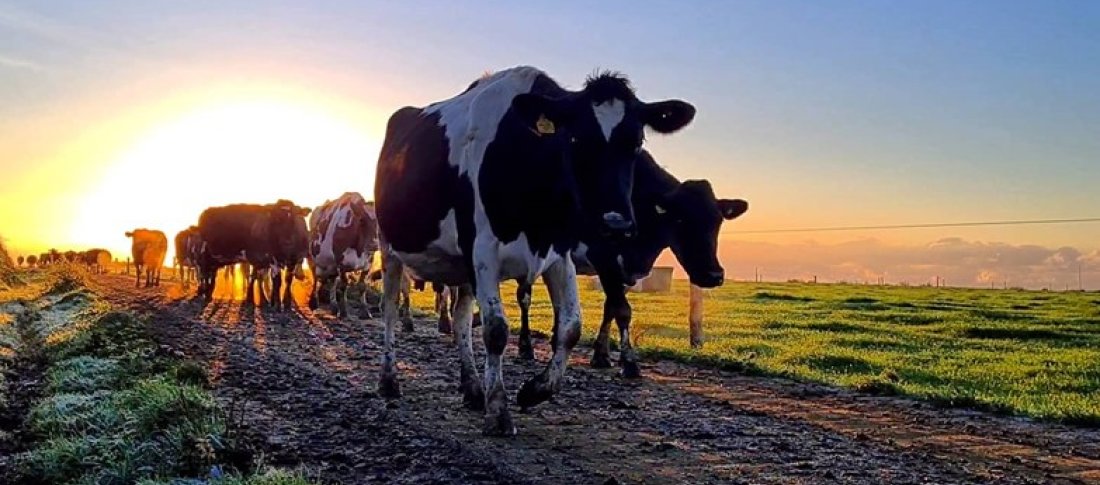With a few sub-zero early mornings under our belts, those halcyon days of summer really are becoming a thing of the past for dairy farmers… until next year, that is! And there’s nothing quite like a sharp frost to bring the importance of correct winter feeding into equally sharp focus.
But why all the seriousness surrounding cow sustenance?
The simple fact is, a dairy cow requires more energy to stay warm in winter and the knock-on effect of inadequate nutrition on Body Condition Score (BCS), milk yield and milk quality can have a huge impact on your farm’s profitability.
Quality of forage first
As the girls move from a predominantly grass-based lifestyle to a barn-housed one and we find them eating their way through our expertly prepared silage clamps at an eager pace, it makes sense to take a look at the quality of this fundamental fodder first.
“Balancing a winter ration should begin with silage analysis to fully understand the quality of the basal forage and enable appropriate supplementation with key macronutrients including fibre, starch, sugar, protein and fat,” – Dr Richard Kirkland, Ruminant Nutritionist, Volac Wilmar Feed Ingredients.
Are your cows getting enough energy?
With UK dairy herds being particularly high performing, meeting the energy requirements to support milk production will always be a challenge – heightened more so by the impact of our inclement winter climate. It goes without saying that this energy supply will inevitably come from a number of sources.
While high D-value silages will improve energy availability to even the highest yielders, providing a range of energy sources gives the ration the balance needed for healthy cows and healthy profits.
Counting the cost of cereals
There’s no denying the energy boost per bite when it comes to cereals over fibre sources in the ration but for every gain in feeding grain, there’s a gripe.
When it comes to wheat and barley, the rapid fermentation of starch in the rumen generates acid, which in turn drives down the pH in the rumen and increases the risk of acidosis. This reduces rumen function and will have a significant impact on the digestibility of that lovingly harvested and clamped fibre, but your milk cheque will be significantly smaller too.
Maize on the other hand not only has a higher energy density but a slower fermentation rate, offering a safer form of starch than other cereals.
Familiar sources of digestible fibre
Digestible fibre can be found in many forms but some commonly fed to the contemporary cow include soya hulls, citrus and sugar beet pulp. All of these will help balance the starchy energy sources, aiding rumen function and milk fat production. But with their lower energy concentration than cereals, they simply will not deliver those vital megajoules within the meal.
Fat packs an energy-rich punch
Not only does fat deliver an energy concentration some 2.5-times that of cereals but it also doesn’t generate acid in the rumen – a significant energy boost while reducing the risk of acidosis.
Fat fact: Dairy cows require 15-20% of their energy supply to be in the form of fat for optimal milk production.
The science behind feed fats certainly provides food for thought, with the blend of fatty acids making up the fat highly influencing the response. But it isn’t as mind-boggling as it might first seem.
Key fatty acids and their function
C18:1 (Oleic acid) – vital for effectively increasing the digestibility of total diet fat to provide an additional energy boost and a more efficient diet. C18:1 is important for autumn calving cows in early lactation when BCS and fertility are high on the agenda.
C16:0 (Palmitic acid) – great for milk fat promotion though care should be taken in early lactation where milk fat production may be increased at the expense of cow body fat, which as suggested above, is far from ideal.
The virtues of C18:1 come with a bit of a caveat in that in order to achieve the listed benefits, it must be delivered through the rumen and into the small intestine, which can only be achieved if it is rumen-protected. Here at Megalac, we achieve that through calcium salt supplements which can avoid breakdown in the rumen, enabling the delivery of the C18:1 directly to the intestine for absorption.
Top tips to take away for better winter nutrition:
- Analyse your basal forage.
- Remember that a truly balanced diet is achieved via a number of feed sources.
- Ensure your dairy cow’s diet is energy rich.
- Keep a close rein on that cereal in the ration.
- Feed digestible fibre to aid rumen function and milk fat production.
- Feed rumen-protected fats for a diet that packs an energy-rich punch and promotes productivity and profitability in your herd.
Of course, there’s more to keeping your herd healthy and happy over winter than just managing what they eat. Discover our top tips for dairy herd health and listen to our podcast for more nuggets of winter dairying advice.
